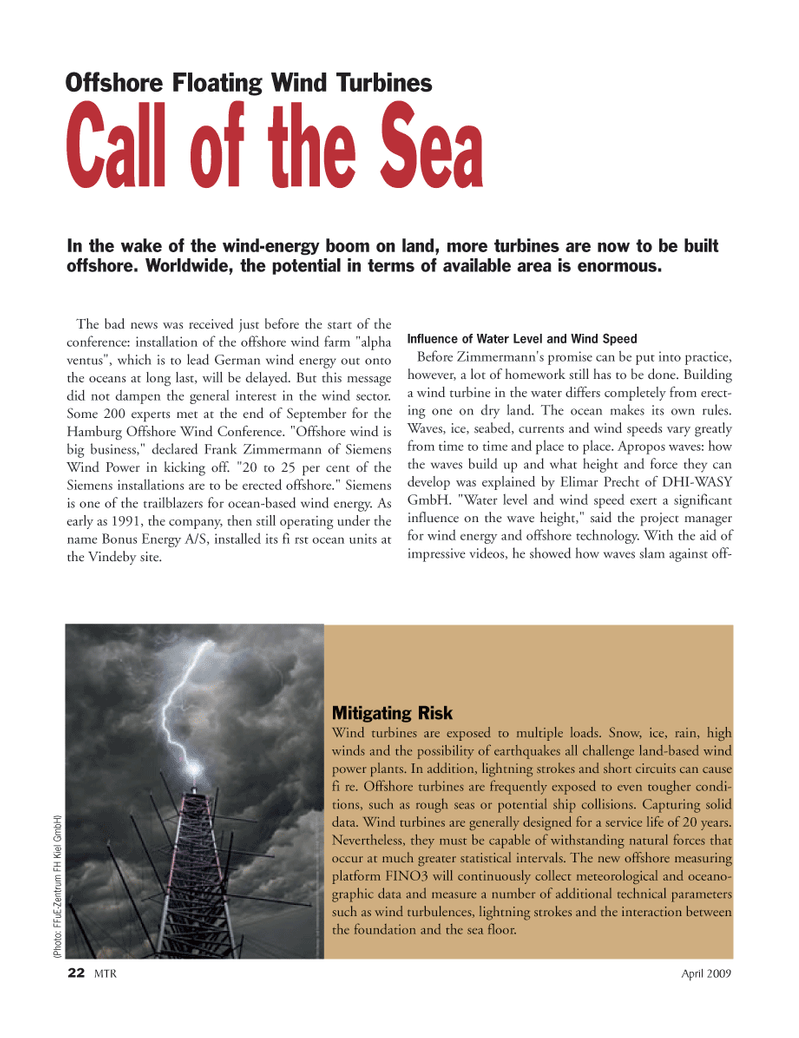
Page 22: of Marine Technology Magazine (April 2005)
Read this page in Pdf, Flash or Html5 edition of April 2005 Marine Technology Magazine
22 MTR April 2009
The bad news was received just before the start of the conference: installation of the offshore wind farm "alpha ventus", which is to lead German wind energy out onto the oceans at long last, will be delayed. But this message did not dampen the general interest in the wind sector.
Some 200 experts met at the end of September for the
Hamburg Offshore Wind Conference. "Offshore wind is big business," declared Frank Zimmermann of Siemens
Wind Power in kicking off. "20 to 25 per cent of the
Siemens installations are to be erected offshore." Siemens is one of the trailblazers for ocean-based wind energy. As early as 1991, the company, then still operating under the name Bonus Energy A/S, installed its fi rst ocean units at the Vindeby site.
Influence of Water Level and Wind Speed
Before Zimmermann's promise can be put into practice, however, a lot of homework still has to be done. Building a wind turbine in the water differs completely from erect- ing one on dry land. The ocean makes its own rules.
Waves, ice, seabed, currents and wind speeds vary greatly from time to time and place to place. Apropos waves: how the waves build up and what height and force they can develop was explained by Elimar Precht of DHI-WASY
GmbH. "Water level and wind speed exert a significant influence on the wave height," said the project manager for wind energy and offshore technology. With the aid of impressive videos, he showed how waves slam against off-
Offshore Floating Wind Turbines
Call of the Sea
In the wake of the wind-energy boom on land, more turbines are now to be built offshore. Worldwide, the potential in terms of available area is enormous.
Mitigating Risk
Wind turbines are exposed to multiple loads. Snow, ice, rain, high winds and the possibility of earthquakes all challenge land-based wind power plants. In addition, lightning strokes and short circuits can cause fi re. Offshore turbines are frequently exposed to even tougher condi- tions, such as rough seas or potential ship collisions. Capturing solid data. Wind turbines are generally designed for a service life of 20 years.
Nevertheless, they must be capable of withstanding natural forces that occur at much greater statistical intervals. The new offshore measuring platform FINO3 will continuously collect meteorological and oceano- graphic data and measure a number of additional technical parameters such as wind turbulences, lightning strokes and the interaction between the foundation and the sea floor. (Photo: FFuE-Zentrum FH Kiel GmbH)
MTR#3 (18-33).qxd 3/27/2009 1:58 PM Page 22

 21
21

 23
23
